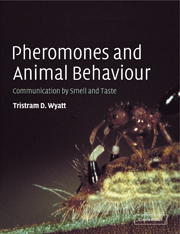Book contents
- Frontmatter
- Contents
- Preface
- Acknowledgements
- 1 Animals in a chemical world
- 2 Discovering pheromones
- 3 Sex pheromones: finding and choosing mates
- 4 Coming together and keeping apart: aggregation and host-marking pheromones
- 5 Scent marking and territorial behaviour
- 6 Pheromones and social organisation
- 7 Pheromones and recruitment communication
- 8 Fight or flight: alarm pheromones
- 9 Perception and action of pheromones: from receptor molecules to brains and behaviour
- 10 Finding the source: pheromones and orientation behaviour
- 11 Breaking the code: illicit signallers and receivers of semiochemical signals
- 12 Using pheromones: applications
- 13 On the scent of human attraction: human pheromones?
- Appendix A1 An introduction to pheromones for non-chemists
- Appendix A2 Isomers and pheromones
- Appendix A3 Further reading on pheromone chemical structure
- References
- List of credits
- Index
10 - Finding the source: pheromones and orientation behaviour
Published online by Cambridge University Press: 03 December 2009
- Frontmatter
- Contents
- Preface
- Acknowledgements
- 1 Animals in a chemical world
- 2 Discovering pheromones
- 3 Sex pheromones: finding and choosing mates
- 4 Coming together and keeping apart: aggregation and host-marking pheromones
- 5 Scent marking and territorial behaviour
- 6 Pheromones and social organisation
- 7 Pheromones and recruitment communication
- 8 Fight or flight: alarm pheromones
- 9 Perception and action of pheromones: from receptor molecules to brains and behaviour
- 10 Finding the source: pheromones and orientation behaviour
- 11 Breaking the code: illicit signallers and receivers of semiochemical signals
- 12 Using pheromones: applications
- 13 On the scent of human attraction: human pheromones?
- Appendix A1 An introduction to pheromones for non-chemists
- Appendix A2 Isomers and pheromones
- Appendix A3 Further reading on pheromone chemical structure
- References
- List of credits
- Index
Summary
Introduction
Finding the source of a pheromone plume in a turbulent flow is a greater challenge than finding an animal producing sound or visual signals. Nonetheless, animals responding to pheromones offer some of the most spectacular examples of long-range responses to stimuli. These include male moths attracted to females over hundreds of metres and perhaps even further. Over evolutionary time, receiving organisms have been selected to search efficiently and to find the source as quickly as possible: many odour sources (whether food or mates) do not last long – the odour source moves or another animal will get there first (Atema 1996).
Searching animals exploit the invisible odour ‘landscape’ created by high and low concentrations of countless molecules in overlapping plumes released by other organisms (Atema 1995; Nevitt 2000). These chemical plumes occur in a wide range of spatial scales and durations. For example, in the sea, they range from the pheromone released by a single planktonic copepod, a few millimetres long, to the odour plumes left by a tuna school 100 metres across. Odour signals have a significant but limited life before the molecules are dispersed or broken down.
How do animals distinguish chemical signals from this chemical cacophony? Signals may be identified by characteristic fine-scale changes in concentration over time or by chemical specificity (Atema 1995). Chemical specificity may come from unique compounds, but more often by unique mixtures, including common molecules in specific combinations (Chapters 1 and 3). Animals may evolve to respond to different aspects of these potential signals. Each animal species extracts its unique information from the chemical world and uniquely contributes to it (Atema 1995).
- Type
- Chapter
- Information
- Pheromones and Animal BehaviourCommunication by Smell and Taste, pp. 206 - 228Publisher: Cambridge University PressPrint publication year: 2003



